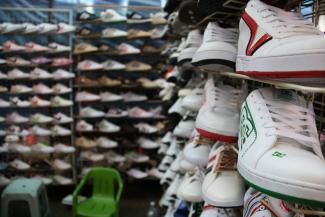Associate Professor Yi Qian of UBC’s Sauder School of Business knows knock-offs. She’s done extensive research into the interplay between counterfeiters and brands, and has found some bright sides to counterfeit entry – as well as insights into how companies can keep their brands secure.

What happens when a brand finds itself getting copied?
Authentic vendors will of course lose some potential customers who buy the knock-offs for much lower prices. But at the same time, when people see the knock-offs, they see it’s a brand worth emulating. So the counterfeiters have actually just given the authentic brand some free advertising. In fact, this has even been Microsoft’s strategy in China: Bill Gates once said, “As long as they’re going to steal it, we want them to steal ours.”
In a study of shoe brands and their counterfeits in China, I found that for high-end shoes, there was a boost in sales after counterfeits entered the market, because the publicity effect outweighed the replacement effect of counterfeit sales. This is especially true if there’s a wide quality gap between the knock-offs and the real thing, as these counterparts capture a very different customer segment that would not have purchased the authentic product anyway. Brands can also devote relatively fewer enforcement resources to high-fashion product lines – especially those designed for younger customers – since counterfeits can help set fashion trends.
 So should they just let it all slide?
So should they just let it all slide?
That’s risky. If you just leave them be, then more counterfeits will enter the market, which could cause bigger problems. Counterfeits could drive the authentic products out of the market if consumers are too wary of mistakenly buying a knock-off.
Typically, brands need to act at some point. In another study of a similar market in China that had been recently flooded with counterfeits, I found that authentic brands tend to improve the quality of their products so they more clearly stand out from the knock-offs; for example, some used better materials that the counterfeiters couldn’t replicate. So there’s actually another positive side to counterfeit entry, this time from the consumer side: by acting as competitors, counterfeiters push authentic brands to step up their game and make better products. To make sure they stay ahead, the best thing for the authentic brands to do is to keep an eye on things: monitor the amount of counterfeiters, and their cost levels, to determine the most efficient course of action.
How should policy-makers react?
It depends on the industry. While I found that the presence of counterfeits can have some benefits in the fashion industry, consumers are much worse off if counterfeiters force pharmaceutical companies to waste their resources on aesthetics. So policy needs to be differentiated by sector – public enforcement should probably be stronger for the safety-prone sectors such as pharmaceuticals than for sectors where the product’s appearance itself has value, such as clothing. For the latter sectors, collaboration between private incentives to self-differentiate and public enforcement can be fruitful.

